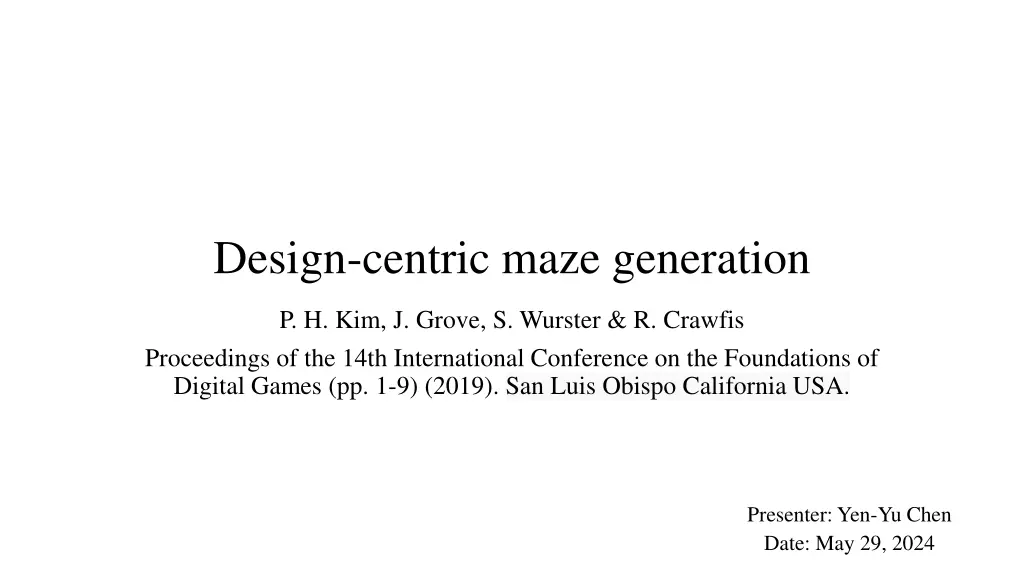
Design-Centric Maze Generation in Game Level Design
"Explore the innovative approach of design-centric maze generation for creating customized mazes in game levels. Learn how designers can input desired properties to craft unique mazes, control solution path topology, and efficiently design game content. Discover the use cases and effectiveness of this method through practical examples and real game level builds."
Download Presentation

Please find below an Image/Link to download the presentation.
The content on the website is provided AS IS for your information and personal use only. It may not be sold, licensed, or shared on other websites without obtaining consent from the author. If you encounter any issues during the download, it is possible that the publisher has removed the file from their server.
You are allowed to download the files provided on this website for personal or commercial use, subject to the condition that they are used lawfully. All files are the property of their respective owners.
The content on the website is provided AS IS for your information and personal use only. It may not be sold, licensed, or shared on other websites without obtaining consent from the author.
E N D
Presentation Transcript
Design-centric maze generation P. H. Kim, J. Grove, S. Wurster & R. Crawfis Proceedings of the 14th International Conference on the Foundations of Digital Games (pp. 1-9) (2019). San Luis Obispo California USA. Presenter: Yen-Yu Chen Date: May 29, 2024
Abstract A maze is a common structure in a game level. When we design game levels having a different purpose of each level, we may desire mazes with different topological properties, such as lots of branches or long straight-ways. Thus, we need the ability to design mazes based on our game mechanics. In this paper, we introduce our design- centric maze generation in which designers can input their desired properties to create their own mazes. Our method also enables the designers to control the topology of the solution path of a maze. Additionally, this method can provide several mazes which satisfy the given desired properties allowing designers to choose the best maze and use it to build game content for a game level. To demonstrate how useful our design-centric method is, this paper provides several use-cases of building actual game levels and shows that we can design the levels effectively using our method. 2
Maze in different game category Ori and the Will of the Wisps Temple Run
Perfect Maze A maze is called perfect when you can pick two random points in it and still find a way between them. 6
Output Generate perfect maze with the starting point (blue) and the ending point (red).
Graph We consider each cell center as a node and lines between cell centers as an edge. Each node has neighboring edges in either vertical or horizontal directions. AMxN grid has M (N 1) + (M 1) N edges in total. 8
Cells Categories turn cells straight cells T-junction cells cross- junction cells terminal cells 9
Solution Path and Dead-end Tree Solution Path Dead-End Tree
Basic Properties Solution Path Starting Point and Ending Point Maze Size #Turns #Straights #Decisions SolutionPathLength #T-Junctions #Cross-Junctions #Terminals 11
Higher-Level Properties Indicates how long a maze path is straight before it meets a turn or junction. Run Relative density of dead-ends and junctions in the maze. River Factor Tendency to have straight-ways in one direction more often than another direction. Bias Indicates the twistiness of a path of a maze. Agility Versus Speed (AVS) Indicates the amount of homogeneity over a maze properties. Homogeneity Indicates how hard it is to recognize the shape of paths from any place while playing a maze. Hidden Factor 12
DESIGN-CENTRIC METHOD Solution Path Generation Stage Maze Generation Stage Input Stage Output Stage 13
Generation Solution Path(2/2) Column to column. 14
Generation Solution Path(1/2) Generate edges that do not give us a loop or cause a disconnect with the previously generated edges so that a valid path is maintained. 15
SBPCG-Based Solution Path Generation Search-Based Procedural Content Generation (SBPCG) Generate a constant number result and choose the best one 16
SBPCG-Based Maze Generation Pre-build a set of machine learning models that are trained to generate spanning trees. To train the models effectively, this method uses the enumerated spanning tree data. Based on the given desired properties, we select a proper model in the set of the trained models and use it to generate spanning trees for the SBPCG approach. 17
Generate Training Data Enumerated spanning tree data to train the models. We avoid enumerating other larger grid domains for training data, and instead implement a new technique for grids larger than 6x6. 18
Applying Hard Constraints Specify some edges of the solution path directly over a grid. 19
Result rolling ball game maze rolling ball game actual gameplay view plumbing game captured maze design tool 20
